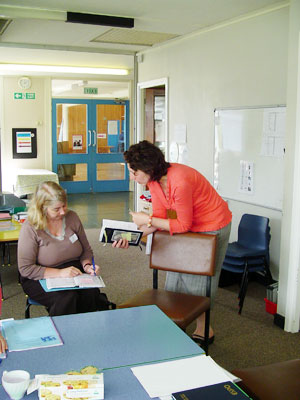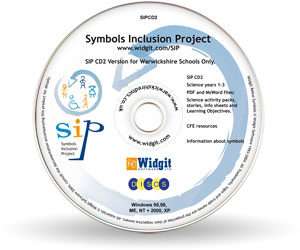How schools get involved with the project
These are some of the ways that schools have become involved with SIP since it started in 2004
 By
attending one of the launches where the SIP 1 resources CD was given
out in 2004/5. These were publicised by sending a flyer to all Primary
Schools.
By
attending one of the launches where the SIP 1 resources CD was given
out in 2004/5. These were publicised by sending a flyer to all Primary
Schools.
- By attending a presentation and /or follow up workshop about the SIP 2 CD in 2005. Again these were publicised County wide. These sessions focused on the In Print programme and resources.
- School Staff who attended Communication Environment Training, which
was given free, were given information about the project.
- Specialist Staff from the Speech and Langauge Disorder Team, who visit
many schools across the county, giving direct support to pupils, suggest
to school staff that the SIP resources would be a useful tool.
 Colleagues
from other teams with the support services publicise the materials in
schools in the same way. The SIP team has held training sessions for
staff who support pupils with Visual Impairment, Hearing Impairment,
Autistic Spectrum Disorder, Physical Disability and Illness, as well
as those working with pre-school children.
Colleagues
from other teams with the support services publicise the materials in
schools in the same way. The SIP team has held training sessions for
staff who support pupils with Visual Impairment, Hearing Impairment,
Autistic Spectrum Disorder, Physical Disability and Illness, as well
as those working with pre-school children.
- Speech and Language Therapists who visited schools recommend the resources
to SENCOs.
- The SIP team attend County wide information sharing sessions for school
SENCOs every year.
- Speech and Language Disorder Team staff in the 7 Speech and Language
Provoisions across the County work with school staff to raise awareness
of the resources and the In Print programme.These Bases are now regarded
as Centres of Excellence in terms of being Communication Friendly Environments
and in using the symbol based resources to support learning.
- Over 170 Schools and settings are registered on the Warwickshire Schools
SIP web site. This enables them to access information, support and new
resources.
- 22 schools sent back a survey in Autumn 2006 about using CIP and CFE in their settings
Warwickshire has 139 primary schools, 25 Junior Schools and 31 Infant Schools - a total of 195 schools. There are also 9 Special schools, 4 Pupil Referral Units and 8 Nursery schools.All these settings were given a copy of Communicate: In Print in January 2006 when Warwickshire bought a County licence. The 36 Secondary schools are being given the programme individually.
Impact in Primary Schools
 Staff
from 62 schools requested the SIP 1 CD in 2004/5
Staff
from 62 schools requested the SIP 1 CD in 2004/5
- Staff from 75 schools attended a presentation about the resources.
- A further 66 went on to attend workshops on how to use Communicate:
In Print.
- When Warwickshire purchased a County Licence in early 2006, a special
CD was made which had all of the SIP resources as an integral part of
the programme. All schools were then invited to awareness raising sessions
about the programme and resources at the 7 Speech and Language Provisions.
These sessions were well attended.
- Since then staff from the Speech and Language Disorder Team and the SIP team have given training in 80 Schools on using the programme and resources.
Impact in Secondary Schools
- Out of the 36 Secondary Schools 18 now have the Communicate : In Print
Programme and have had some input from Staff from the Speech Language
Disorder Team. CIP is usually loaded in the Learning Support Department,
although some have put it on the school network.
- 4 have now had whole schools staff training in Communication Friendly Environments, with another 2 booked in.
Impact in Special Schools and Pupil Referral Units
- 6 of the 9 Special Schools use the programme and resources.
- Oak Wood Primary and Secondary School in Nuneaton used Widgit symbols
for the sinage around the new school site. They have also had whole
school staff training from the SIP team.
- 2 of the 4 Pupil Referral Units use the Programme and resources and have had staff training from the SIP team
Warwickshire Web Site Downloads
Between October 2006 and November 2007 downloads from the site were:
- Maths 275
- Classroom Resources 228
- RE 103
- Geography 66
- Cross Currricular Activities 288
- Science 543
- History 365
- Literacy 309
By the end of January 2008 this had increased to
- Maths 326
- Classroom Resources 265
- RE 123
- Geography 99
- Cross Curricular Activities 362
- Science 656
- History 444
- Literacy 392
The figures for mid April 2008 were
- Maths 397
- Classroom Resources 301
- RE 149
- Geography 158
- Cross Curricular Activities 426
- Science 787
- History 515
- Literacy 488
